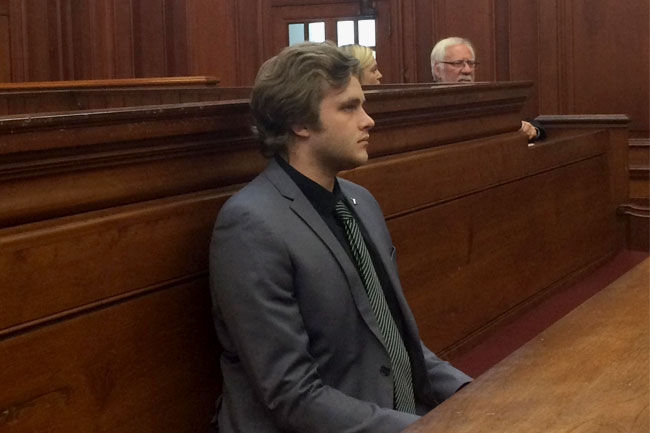Highbury Media’s own legal expert, Cape Town Etc contributor Tracey Stewart breaks down the riveting details of the horrifying axe murder trial that has the whole Mother City enthralled again this week. Here’s her perspective on the cross-examination of the first officer on the scene, Sgt Kleynhans.
Accused’s Demeanor
In a rather startling revelation, today Kleynhans admitted that he had made a mistake in describing the demeanour of the accused when he first arrived at the scene although he wasn’t sure which version was actually correct. Most of us may not think it very important to distinguish between the use of the words “Panicked and emotional” vs. “traumatised” but it was quite obviously an important point for the defence.
Advocate Pieter Botha cleverly drew this comparison for the court when he got Kleynhans to admit that there was a big difference between his written statement which indicated that:
“He arrived at the property, the door was ajar and he could see the accused standing in his shorts, appearing traumatised. He approached him and wanted to comfort him so he asked him to sit down”
Versus the version he gave under oath in court approximately two years later:
“He arrived at the property, the door was ajar and he could see the accused standing in the door looking panicky and emotional, he took out his firearm as he approached the accused”
One version makes the accused seem more suspicious than the other. Kleynhans did admit to having a bad memory, and he also admitted he had read the newspapers and media on the trial and he worked in proximity with officers investigating the matter over the last two years. Is it reasonable to assume that these factors may have influenced the evidence he gave in court?
Possible tampering with the scene
It’s the state’s job to show that the crime scene was properly dealt with, and the first officer on the scene is obviously quite crucial in that regard. Kleynhans confidently provided the court with a view of the scene as he arrived. He testified that he had not touched anything on the scene at all except the handbag which he went through for medical purposes.
Today, the defence, through cross-examination, alluded to the fact that the scene may very well have been tampered with by more than one person and perhaps Kleynhans was not quite as observant nor as confident in his version as he came across in his evidence in chief. The defence also mentioned bloodied footprints on the stairs and in Henri’s room which they would show were left by the police entering and exiting the scene.
Crucial admissions
Kleynhans admitted to stating that the door was open in his statement but in court he said it was ajar. Advocate Botha was very interested in why Kleynhans felt the importance to testify that it was “ajar” rather than “open” as was in his written statement. His interest was shown to be important for the following reasons:
- Kleynhans said under cross-examination that he had opened the door more, in order to exit into the garden. So he has admitted he touched something else on the scene and didn’t disclose this in his evidence in chief, especially when he was looking at the open door on scene photographs and confirmed under oath that it looked exactly as it did when he arrived on the scene.
- In my legal view, I don’t believe the fact that the door was open or ajar is relevant at all but what may be relevant, and we will need to wait for Advocate Botha’s argument on this, is that (1) Kleynhans now said he pushed the door open further and thus may have contaminated it with his fingerprints or DNA (the court will wait for expert opinion on this). (2) Alternatively, given Advocate Botha’s line of questioning on this point, I think that it may be more important for the defence, that the court should be careful to apply too much weight to his statement in chief that “he did not touch anything on the scene”.
Observation of the Scene
As the first officer on the scene, it would be important for the state to have Kleynhans counter any evidence lead by the defence regarding tampering with the scene. In order to do so, the state needs to know how the scene was on arrival quite well, through Kleynhans’ evidence. Alternatively, the state will have to rely on expert evidence on blood stains, the positioning of the axe, etc.
After today’s cross-examination, the evidence to be led by the state’s expert has become very important as Kleynhans testified that he can’t recall quite a number of blood stains throughout the property including boundary walls, the kitchen etc.
Obviously, human error needs to be taken into account when considering evidence, the circumstances in which Kleynhans gave his statement as well as his testimony in court, and the fact that this occurred two years ago. These are all factors which Judge Desai will give due consideration to when determining how much weight to attribute to his evidence.
Being the first officer on a scene like this is no doubt an exceptionally tough task and I personally have the greatest sympathy with Kleynhans. Today he dealt with the loud and booming voice of a seasoned cross-examiner, who has 22 years of experience under his belt, and he did well under those circumstances. Although it certainly appears that some very important concessions were made by Kleynhans today, which may favour the defence’s version, this was witness number one of many more witnesses and evidence to be lead. It is far too early to make assumptions for or against any side. My tip will be to wait for the expert evidence. Obviously, with the exception of Marli’s evidence, this case will likely be decided on expert evidence.
Photography Justin Williams






